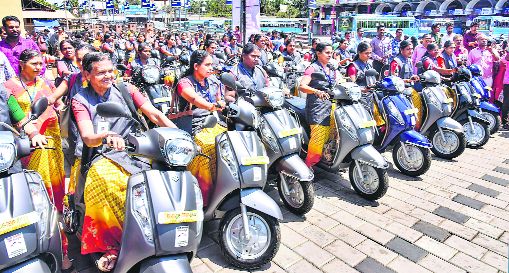
More atmanirbhar: The number of women reporting that they earned the same as or more than their husbands has doubled.
Meeta Rajivlochan
IAS officer and Author
The Covid pandemic became yet another opportunity to perpetuate the myth of the disempowered Indian woman. Be it stories of an increase in domestic violence or women leaving the workforce, these were all used to perpetuate the myth of the battered, helpless Indian woman.
Facts from the ground tell us a different story and here we do not need to refer to the mythologies surrounding warrior women like Rani Durgavati or those adept at governance like Ahilyabai Holkar. Even the normal Indian woman is quite something. A little bit of help, a few key attitudinal changes would do wonders in enabling the women of India to achieve their full potential in harmony with the needs of 21st-century India.
For a woman who is in trouble, the most immediate source of support is the local police. Because of the efforts of the National Commission for Women, 19 states run such helplines. These helplines cover 73 per cent of the female population of India. This means about 42.9 crore women can seek help from the police 24x7 whenever they want to.
Thana-level data for the past five years from large states like Madhya Pradesh and Chhattisgarh and smaller ones like Himachal Pradesh shows that there was no increase in complaints of domestic violence during the lockdown period from late March till May this year. Maharashtra and Andhra Pradesh actually reported a decrease. Odisha reported an increase that began in the last quarter of 2019, much before any lockdown began. The Chhattisgarh police helplines displayed an increase in domestic violence calls from February 2020 onwards. Police helplines in Uttar Pradesh showed no increase in domestic violence calls till April 2020.
Like any other form of violence, domestic abuse is inexcusable. Insofar as it is culturally sanctioned, those strands of culture need to be changed. India is working hard to bring about these changes, and it seems to be succeeding. A glimpse of this transformation is visible through the National Family Health Surveys.
And to make things easier for us, we need to take note of the fact that there are no gender wars in India. Surveys show that a significant number of men do believe that women should be treated as equals, have financial independence, participate in decision-making and have freedom of movement. If anything, it is the women who need a little nudge to change.
A comparison of results of the two NFHS surveys conducted in 2005-06 and 2015-16 shows what has changed and what has not.
From 2005-06 to 2015-16, there was a slight improvement in the number of women who disapproved of being beaten by their husbands. Less than half the women surveyed in 2005-06, or 46 per cent, believed that men were not justified in beating their wives for any reason. Ten years later, the proportion of women with such beliefs had improved only by roughly three percentage points to 49.
On this point, though, husbands did not seem to fully agree with their wives. The number of husbands who disapproved of beating their wives rose by a far larger proportion — from 49 per cent to 58 per cent.
Even on an issue like the wife refusing sex, more husbands than wives believed that women have a right to refuse sex if they do not wish it. The survey of 2015-16 showed that 85-90 per cent women disapproved of beating for refusing sex while 90-92 per cent men disapproved of beating in this case. Interestingly, among the younger age-groups, there was more agreement on this issue. Among men and women below age 24, roughly 90 per cent agreed that wife-beating was unjustified if the wife refused sex. It was in the older age-group of couples above 40 that nearly twice as many men than women disapproved of wife-beating for refusing sex.
These attitudinal changes are reflected in the drop in the proportion of ever-married women who suffered any kind of spousal violence from 39 per cent to 33 per cent in 2015-16 as compared to 10 years earlier.
Women have had much greater control over their own cash earnings than over the household expenditure. Four out of five women in 2015-16, and also 10 years earlier, decided alone or jointly how to use money they themselves earned. A greater change was witnessed in the manner in which women related to money matters and decision-making within the family. In 2005-06, only seven per cent of the youngest cohort of married women had a bank account and only 25 per cent participated in major household purchase decisions. In 2015-16, 42 per cent of the youngest cohort had bank accounts and 55 per cent participated in major household purchase decisions.
In the case of older women, the figures were almost as dramatic. The percentage of those having bank accounts that they used tripled from 20 to 60. The percentage of those participating in major household purchase decisions had gone up from roughly 62 to 77 for this cohort.
Women have begun to buy and use mobiles. Today, 46 per cent women in India have mobiles that they themselves use. The number of women reporting that they earned the same as or more than their husbands has doubled. Three out of four men believed that women should have an equal or greater role in decision-making. This proportion did not change significantly in 10 years.
Women’s participation in the labour market did drop. But it was linked with better incomes, a corresponding hesitation to do manual labour and the total absence of childcare facilities. A survey conducted across seven major states said that 72 per cent skilled women had job offers as compared to 85 per cent men. However, women were far more reluctant to do jobs that meant going out of their district. One out of three women refused job offers while only one out of four men refused job offers.
It occurs to us that the key enabler for women to continue with jobs is the provision of childcare facilities and support for migration. Small actions like helping women find accommodation, opening bank accounts and, above all, making creches available would go a long way towards improving female participation in the workforce.
Data says that women in India today are more atmanirbhar. A little tweaking in the form of providing childcare facilities and designing our towns and transport systems to be more women-friendly would go a long way in enabling them to achieve their full potential.
Views are personal
Join Whatsapp Channel of The Tribune for latest updates.




























